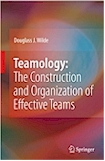

|
特定非営利活動法人失敗学会 |
広告掲載について | 広告掲載について | 広告掲載について | 広告掲載について |
|
ワイルド先生、“Teamology”出版のお知らせ『ティーモロジー』-効果的チーム作りとその管理- Douglass J. Wilde 著Springer-Verlag 2008年11月発行 
アマゾンから購入するには右写真をクリック<<
2006年6月、スタンフォード大学からワイルド教授をお招きし、御出講していただいた 第40回懇談会( MBTIとは、その発案者達の苗字を頭に置いた言葉、Myers-Briggs Type Indicatorを略したものだが、 マイヤー・ブリッグスの性向指数とでも訳せばいいだろう。アンケート形式の質問表に答えると、 その結果より回答者の性向がわかるというものである。 MBTIなど、ユングの性向タイプについて研究、事業を行う組織は数多くあるが、 その中の"Center for Applications of Psychological Type"による "Journal of Psychological Type"に、 昨年10月から今年1月にかけて Reynierse と Harker による論文が発表され、アメリカで話題になっている。 統計解析により、MBTIの結果に有意差が認められなかったというのだ。 この業界にとっては激震が走ったと見るべきだろう。 このユングの性格タイプについて、唯一数学的アプローチを行っているのがワイルド先生である。 そして今、この数学的分析が注目を集めている。 第40回懇談会( "ユングの性格論を利用したチーム形成", 飯野謙次, Douglass J. Wilde, 機械の研究, 第59巻, 第1号, pp.155-162, 養賢堂, 2007 本記事最後にワイルド先生との交信記録を記しておく。 本の出版に先立ち、どのようなやり取りがあるか、英語、そして数学に自信のある方には一読をお勧めする。
[飯野謙次]
From: Doug To: kenji Subject: Re: Chapter 4 ---- I see you are drawn to the combinatorial optimization aspects of this team business, Kenji. I myself can't imagine a single measure of effectiveness of a team formation plan. Personally I just look to see how many teams have to "reach" for some modes, a rough criterion used in the Ch. 4 discussion of the evaluation of team formation plans (p. 8). I also think any measure of effectiveness should be based on cognitive modes rather the MB variables. A technical point: the transformation from MB 4-space to modal 4-space is "homogeneous" rather than "affine" because the origins map to each other. By the way, the transformation is "orthogonal" but not "normal". Length, which has no meaning anyway in this context, is NOT preserved under the transformation, so the transformation is not even Euclidean. I stumbled on this point when I put together the earlier theory that MM made into a web site for ME310. I had the site withdrawn when I realized the error, but I'm afraid YS did use the MM site in his research. I hope I talked him into correcting things. Keep on truckin・ Quoting kenji: > Thanks Doug, > > By the way, because the I-E, P-J, S-N, T-F > characterization has only 4 degrees of freedom from > the pairing, each individual is represented by a > point in 4-space. Then the mapping to the ES-IN, > EN-IS, ET-IF, EF-IT space (which is also a 4-space) > is an affine transformation. > > When we call the 4 axes in the original space I, P, > S, T, then the goal is to group all the points in > groups of 4 points so that for each group, > Imin * Imax < 0 > Pmin * Pmax < 0 > Smin * Smax < 0 > Tmin * Tmax < 0 > > This ensures all the eight characters have a member > with a positive component. We also try to form the > groups so that, > Abs(Sum(positive I's)) > Abs(Sum(negative I's)) (=Abs(Sum(positive E's))) > Abs(Sum(positive P's)) > Abs(Sum(negative P's)) > Abs(Sum(positive S's)) > Abs(Sum(negative S's)) > Abs(Sum(positive T's)) > Abs(Sum(negative T's)) > > are all fairly big. If we were to find the group > that maximizes say the multiple of these 8 numbers, > it is easy. The difficulty is in grouping all > points so that each group has a good share of > these 8 quantities. > > There is a finite number of combinations, so if we > can find an evaluation function, then the computer > can handle the grouping. > > The evaluation function will depend on the > organization policy. For schools it is probably the > grouping with the smallest difference between the > minimum and maximum of each of the above 8 numbers, > across all groups. For F-1 racing, the goal is to > find the champion team that has the largest > combination of the above 8 numbers. > > Please correct me if I am wrong. > > Sincerely, > * kenji > > Doug wrote: > > > Ahoy (Team) Mates! > > > > Here at last is Ch. 4 on actually forming "great" teams. > > If you'vedigested the earlier chapters, you'll plunge > > right in, or have your students make their own teams > > after you've put them in "affinity groups". If you're > > still leery of cognitive modes you can form teams by > > "quick-and-dirty" sorting on the MBTI letters, a section > > near the end of the chapter. > > > > * D * |
|
|||||||||||||||||||||||||||||||||||||||||||||||||||||||||||||||||||||||||||||||||||||||||||||||||||||||||||||||
Copyright©2002-2025 Association for the Study of Failure |
|||||||||||||||||||||||||||||||||||||||||||||||||||||||||||||||||||||||||||||||||||||||||||||||||||||||||||||||||